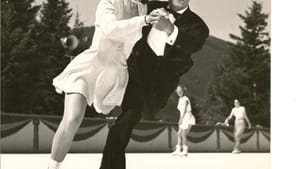Stay in the Loop
BSR publishes on a weekly schedule, with an email newsletter every Wednesday and Thursday morning. There’s no paywall, and subscribing is always free.
Before Meryl and Charlie — Irene and Walter
When ice dancing was young: talking with Irene Muehlbronner

Before we loved Meryl and Charlie, we loved Irene and Walter. Meryl Davis and Charlie White, who just won the gold medal in ice dancing at the Sochi Olympics, may have perfected the sport, but Irene and Walter Muehlbronner pioneered it, having represented the United States in ice dancing at its first major international competition in London in 1950. They placed third behind another American team and a British pair. Unlike Meryl and Charlie, Irene and Walter choreographed their own free dance to music they had pieced together themselves. Irene’s mother made her costume, and friends helped them finance their trip. They had no coach.
She was Irene Maguire back then, a singles skater before she met Walter at the Brooklyn Skating Club. He was fresh out of the military, having been stationed in London, where he skated five nights a week and learned to dance the English way. “The British were the forerunners,” Irene, now 84, said recently from her home in Blue Bell. “The American style was more stilted.” They competed in pairs as well, and her strength as a soloist combined with his British training helped them develop a smoothly romantic manner that led to a variety of medal-winning performances, including two at the 1949 North American championships held at the Philadelphia Skating Club & Humane Society’s rink in Ardmore.
The history of that club stretched back a century, to 1849, when its predecessor was formed in Philadelphia, the first skating club in America. The original club later merged with the Humane Society, a group dedicated to rescuing people fallen through the ice, and the combined organization eventually moved to Ardmore, where it continues to operate a rink and ambitious skating program. Before the advent of such rinks, however, Philadelphians were able to skate on frozen ponds or rivers for, at most, a few weeks each winter. But that didn’t deter stalwarts such as Benjamin West, who could skate as well as paint, and became, according to his biographer “one of the most accomplished skaters in America” in addition to one of its finest artists. West moved permanently to England, where he resumed his hobby at a basin in Kensington Gardens, dazzling onlookers with his tricks. During the Civil War, Jackson Haines, skating’s first international star, performed at the Continental Theatre on Walnut Street. Legend has it that Haines once worked as a dancing master in the city, an experience that informed his innovative, graceful routines on ice set to music. Among other accomplishments, Haines invented the sit spin, supposedly devoting nearly a decade to getting it just right.
The Muehlbronners came to Philadelphia on the promise of jobs as skating instructors. They retired from competition in 1950 because, as Irene said, “We couldn’t afford to stay amateur. I remember being on a bus in New York, talking about what we would do. We thought we would start teaching. Walter said he would make up a flyer and send it to all the clubs.” They married in 1951 and did begin to teach, but their performing days were not quite over. The Ice Follies offered them a contract, and they agreed to join the show for one year. Billed as “Walter and Irene,” they stayed for seven. “The Follies was like a family,” she said. “It was a wonderful experience.” Afterward, they taught and raised four sons, three of whom played ice hockey. Walter died in 2005.
Irene followed the ice dancing competition at the Sochi Olympics and praised the polish of the American champions: “They’re seamless. Nothing starts and finishes — it just keeps going, keeps flowing.” The Muehlbronners did not have a phalanx of professional advisers, as competitors do now, but they had pluck. Irene recalled an incident during those championships in Ardmore, which she believes were the first to be televised. The rink had no barrier surrounding it and chairs for spectators had been placed near the perimeter. During the Muehlbronners’ program, as they were skating backward, Irene tripped over a blanket that had draped onto the ice. She fell down but Walter soldiered on, keeping pace with the music as he was supposed to do back then. “I got right up and raced after him and made it there just in time for the final lift,” she laughed. “We got a big hand for that.”
Sign up for our newsletter
All of the week's new articles, all in one place. Sign up for the free weekly BSR newsletters, and don't miss a conversation.

 Sharon Skeel
Sharon Skeel